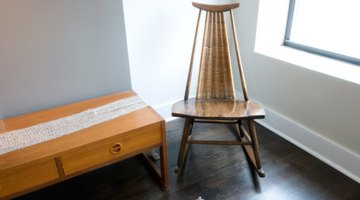How to Clear Coat Furniture
Refinishing furniture, whether a wood chair or dresser, is a challenging yet rewarding endeavor. Once you have painted or stained the wood furniture, treating the object with a protective clear coat will benefit the furniture and prolong the lifespan of the finish.

Some people choose to apply clear coat over an old finish. For painted and stained furniture aerosol spray polyurethane is the easiest method of applying a clear protective coat to the wood. You can brush polyurethane onto furniture and it is available in matte, satin, gloss or semi-gloss finishes. Polyurethane, sprayed or brushed, requires a long drying period.
Over Painted Furniture
-
Put on a protective face mask and work gloves to protect against inhalation hazards and skin irritation before beginning your project. Prepare your work area. If you’re brushing the polyurethane onto the painted furniture, stir it with a paint stir stick. Don’t shake aerosol spray polyurethane as this will cause air bubbles when sprayed.
-
Spray or brush (in even, short strokes going with the grain or direction of the paint application) one thin coat of polyurethane over the surface of the painted furniture. Allow the polyurethane to dry for about six hours or until completely dry with no tackiness or stickiness.
-
Spray or brush another coat of polyurethane over the first layer. Allow this second coat to dry for about six hours. Repeat for a third coat. Three layers of polyurethane will usually suffice. If you’re using high gloss polyurethane and prefer a thicker appearance, apply four coats.
Over Stained Furniture
-
Paint or spray a clear wood sealer onto the stained furniture in the direction of the wood grain. Sealing the wood helps the polyurethane clear coat dry faster. Allow the sealant to dry.
-
Spray or paint a coat of polyurethane over the dry coat of wood sealer in the direction of the wood grain. Allow the polyurethane coat to dry. Allow the polyurethane to dry for about six hours or until completely dry with no tackiness or stickiness.
-
Spray or paint another coat of polyurethane over the furniture. Allow the clear coat to dry for six hours or until completely dry.
Over Old Finish
-
Determine, to the best of your knowledge, what type of original finish the furniture had. Shellac will not accept polyurethane finishes. Use an oil-based varnish instead of polyurethane if the furniture was shellacked.
-
Clean the furniture’s old finish with a wood cleaner to remove furniture polish and wax residues. Some people choose to sand the surface until smooth to the touch but if you are dealing with furniture stained or painted before 1978 lead could have been in the stain or paint ingredients. Clean the furniture with wood cleaner again to remove sanding residue.
-
Apply a clear wood sealant by spraying or brushing in the direction of the wood grain. Many old finishes are uneven with exposed unfinished wood. Sealants provide a fresh, evenly treated surface to accept the clear coat.
-
Spray or paint a clear coat of polyurethane or oil-based varnish over the furniture in the wood grain direction. Allow the clear coat to dry before applying a second coat.
Things You Will Need
- Protective face ventilation mask
- Work gloves
- Aerosol spray oil-based polyurethane
- Polyurethane
- Paint stir stick
- Paintbrushes, stiff bristles
- Wood sealer
- Wood cleaner
- Oil-based varnish, optional
Warning
Always use sealing, staining and clear coat products in a well-ventilated area. If working in an outside, open or semi-open environment choose a non-windy day with little humidity or chance for rain.
References
Writer Bio
Louise Harding holds a B.A. in English language arts and is a licensed teacher. Harding is a professional fiction writer. She is mother to four children, two adopted internationally, and has had small businesses involving sewing and crafting for children and the home. Harding's frugal domestic skills help readers save money around the home.
Photo Credits
- Jupiterimages/Photos.com/Getty Images
- Jupiterimages/Photos.com/Getty Images
More Articles



